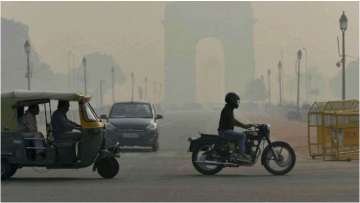The post-Diwali pollution levels in Delhi are likely to be the lowest as compared to the past three years as favourable wind speed would possibly negate the impact of firecracker emissions and stubble burning, according to a government air quality monitor.
Although Delhi's air quality is predicted to touch the "severe" mark in the early hours on Monday, the peak level of PM2.5 is likely to be the lowest in the past three years, the System of Air Quality and Weather Forecasting and Research (SAFAR) said in a special report on Diwali.
Favourable speed of surface winds will greatly help in dispersion of pollutants, it said.
PM 2.5 is particulate matter equal to or less than 2.5 microns in diameter. These tiny particles can enter deep into the lungs and even the bloodstream.
Last year, the overall air quality index post-Diwali was recorded in the "severe plus emergency" category at 642. In 2017, the AQI was recorded at 367, while it was 425 in 2016.
An AQI between 0-50 is considered "good", 51-100 "satisfactory", 101-200 "moderate", 201-300 "poor", 301-400 "very poor", and 401-500 "severe". Above 500 is "severe-plus emergency" category.
A "severe plus emergency" AQI essentially means that even healthy people may suffer from respiratory illnesses on prolonged exposure. This air will seriously affect those with ailments, according to a SAFAR advisory.
The SAFAR said the farm fire count in Haryana and Punjab had more than doubled over the past two days, surging from 1,200 to 2,700, and the share of stubble burning in Delhi's pollution was likely to increase significantly from Tuesday.
On Sunday, the share of smoke from farm fires in Delhi's PM2.5 concentration is expected to be 19 per cent.
"The highest impact of firecracker emissions (if any) is expected in the early morning of October 28 -- from 1 am to 6 am," the report said. "In the normal course, the impact of stubble burning is expected to be moderate and if no additional emissions due to firecrackers are added, the air quality will remain in the very poor category during the Diwali period."
"The biomass plume transport-level winds are now northwesterly, with a high potential to transport significant biomass plume in the next three days, but the expected moderate surface winds in Delhi will not allow rapid accumulation of pollutants for a longer period," it said.
The SAFAR said the favourable speed of high boundary-layer winds (20 kmph) on Sunday night and on Monday morning would counter the expected high impact of firecracker and biomass emissions.
"Thereafter, winds are expected to become calm and the biomass-related contribution may touch a peak value (~25 percent) on October 29 and 30. AQI will continue to remain very poor but no prolonged extreme pollution event is expected," the report said.
The SAFAR also predicted that Delhi University (North Campus), Pusa, Rohini-Punjabi Bagh, Wazirpur, Jahangirpuri, DTU and Bawana, and other major residential areas could turn out to be the most-polluted locations on Sunday night.
Whereas, Gurgaon, Ayanagar and Nehru Stadium are likely to emerge as the least polluted locations, it said.
Latest India News
